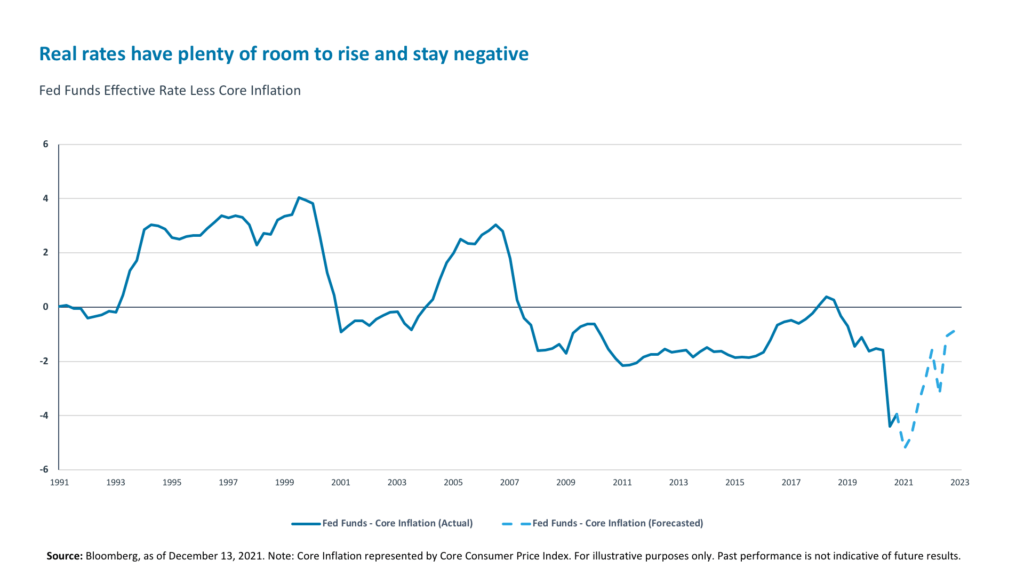Arguably the most important Fed meeting of the year takes place this week. After a series of incremental steps to telegraph to the market that they will be tapering from a record level of monetary accommodation, many may perceive this particular meeting as the pivot from accommodative to restrictive, from dovish to hawkish. We think this would be a mischaracterization, and any negative market reaction will likely exaggerate the degree of tightening that is actually taking place. Here is why.
Fed finally marking to market
There are three updates investors will be watching for this week from the Fed – on the pace of tapering, the number of rate hikes in 2022, and the terminal long-run rate. However, the Fed is unlikely to say anything that the market does not already know.
They are likely to accelerate the pace of tapering from $15 billion to $30 billion a month, putting them on track to stop purchases by March.1 We expect them to put a couple of rate hikes on the table for 2022. Whether they will raise the 2.5% long-run equilibrium rate remains uncertain, but we doubt that the current bout of inflation justifies it. In aggregate, the actions we expect during this meeting should not come as a surprise to anyone – the markets have already been calling for the Fed to finish tapering by March and have priced in two and a half rate increases in 20221. This week is all about the Fed finally marking its own estimates to market.
Tapering is not tightening
Nevertheless, the trepidation ahead of the Fed decision tomorrow is understandable amidst the spread of Omicron, and was reflected in Monday’s and today’s fall in stocks, led by tech shares. The 10-year yield and the yield curve are acting like the Fed will be slamming the brakes on economic growth: The 10 year UST yield of 1.44% implies a material slowdown in growth ahead, versus an economic consensus forecast of 3.7% for U.S. GDP in 20222, and the yield curve is as flat as it was to start the year, before vaccines prompted broad economic re-opening. But these metrics seem to us to exaggerate the degree of tightening expected. The Fed is not actually tightening monetary policy to slow economic activity, rather just beginning to withdraw accommodation from an economy that no longer needs it. Even rate hikes should not initially be thought of as tightening.
 How so? In economics, there is a so-called natural rate for short-term interest rates (r*), which is the real rate expected to prevail when the economy is at full strength, inflation is stable, and the Fed is neither stimulating nor restricting economic growth.3 This is periodically updated and published by the Federal Reserve Bank of New York. However, this exercise was suspended in November last year due to the pandemic.
How so? In economics, there is a so-called natural rate for short-term interest rates (r*), which is the real rate expected to prevail when the economy is at full strength, inflation is stable, and the Fed is neither stimulating nor restricting economic growth.3 This is periodically updated and published by the Federal Reserve Bank of New York. However, this exercise was suspended in November last year due to the pandemic.
Pre-pandemic r* was roughly 1% in real terms, and the federal funds rate of 2.5%, given inflation of 2%, was certainly not restraining economic growth.3 Today, the real federal funds rate is deeply negative at around -4%.1 Assuming r* did not change much since before the pandemic, rates are well below a neutral level with plenty of headroom for the Fed to hike rates just to get back to neutral. Using market federal funds rate expectations and consensus forecasts for core CPI inflation, we estimate that even by the end of 2023 the real rate will remain below 0% and, therefore, below a neutral level.4 As such, labeling the Fed’s actions as “tightening” is premature. To reiterate, this is just dialing back expansionary policy that the economy no longer requires.
Equity returns to slow but remain positive
We do believe that a less accommodative stance from the Fed is likely to slow the pace of equity returns, but it should not derail them altogether. Prior experience suggests that earnings multiples do not expand but rather stay in a narrow range when quantitative easing stops, yields rise, and/or interest rate increases are on the horizon.1 However, equity returns may still remain positive, as was the case during the 2004 to 2006 rate hiking cycle (see chart below).
 This is because economic and earnings growth tend to drive the markets more than multiple expansion. Next year, growth is expected to remain robust, with global GDP forecast to grow 4.4% (down from 5.8% in 2021) and S&P 500 earnings should grow close to 10%. These estimates suggest potential 8-10% upside for the S&P 500.
This is because economic and earnings growth tend to drive the markets more than multiple expansion. Next year, growth is expected to remain robust, with global GDP forecast to grow 4.4% (down from 5.8% in 2021) and S&P 500 earnings should grow close to 10%. These estimates suggest potential 8-10% upside for the S&P 500.
For high-multiple companies, investors should not bank on continued multiple expansion but should focus on whether the companies will be able to deliver (and preferably over-deliver) on growth expectations. We believe companies in Biotech, Software and Energy should be able to do that. Broadly, we also believe that in 2022, investors will potentially need to add two types of investments into their portfolios to help deliver above-inflation returns – hyper growth and inflation/rate-shock absorbers. We will detail these further in our 2022 Outlook, to be released in early January.
The next weekly commentary will be released on January 4, 2022. In the meantime, we wish you and your family and friends all the very best this holiday season!
1. Bloomberg, December 13, 2021
2. Bloomberg, December 10, 2021
3. Federal Reserve Bank of New York, Measurig the Natural Rate of Interest, as of August 2020.
4. Bloomberg, Trading Ecomonics, December 13, 2021
IMPORTANT INFORMATION
The material herein has been provided to you for informational purposes only by iCapital, Inc. (“iCapital”). This material is the property of iCapital and may not be shared without the written permission of iCapital. No part of this material may be reproduced in any form, or referred to in any other publication, without express written permission of iCapital.
This material is provided for informational purposes only and is not intended as, and may not be relied on in any manner as, legal, tax or investment advice, a recommendation, or as an offer to sell, a solicitation of an offer to purchase or a recommendation of any interest in any fund or security. You should consult your personal accounting, tax and legal advisors to understand the implications of any investment specific to your personal financial situation. This material does not intend to address the financial objectives, situation or specific needs of any individual investor. Alternative investments are complex, speculative investment vehicles and are not suitable for all investors.
The information contained herein is an opinion only, as of the date indicated, and should not be relied upon as the only important information available. Any prediction, projection or forecast on the economy, stock market, bond market or the economic trends of the markets is not necessarily indicative of the future or likely performance. The information contained herein is subject to change, incomplete, and may include information and/or data obtained from third party sources that iCapital believes, but does not guarantee, to be accurate. iCapital considers this third-party data reliable, but does not represent that it is accurate, complete and/or up to date, and it should not be relied on as such. iCapital makes no representation as to the accuracy or completeness of this material and accepts no liability for losses arising from the use of the material presented. No representation or warranty is made by iCapital as to the reasonableness or completeness of such forward-looking statements or to any other financial information contained herein.
Securities products and services are offered by iCapital Markets, an SEC-registered broker-dealer, member FINRA and SIPC, and an affiliate of iCapital, Inc. and Institutional Capital Network, Inc. These registrations and memberships in no way imply that the SEC, FINRA, or SIPC have endorsed any of the entities, products, or services discussed herein. Annuities and insurance services are provided by iCapital Annuities and Insurance Services LLC, an affiliate of iCapital, Inc. “iCapital” and “iCapital Network” are registered trademarks of Institutional Capital Network, Inc. Additional information is available upon request.
© 2023 Institutional Capital Network, Inc. All Rights Reserved.

















